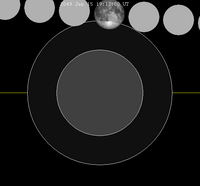|
May 2049 lunar eclipse
A penumbral lunar eclipse will occur at the Moon’s ascending node of orbit on Monday, May 17, 2049,[1] with an umbral magnitude of −0.2073. A lunar eclipse occurs when the Moon moves into the Earth's shadow, causing the Moon to be darkened. A penumbral lunar eclipse occurs when part or all of the Moon's near side passes into the Earth's penumbra. Unlike a solar eclipse, which can only be viewed from a relatively small area of the world, a lunar eclipse may be viewed from anywhere on the night side of Earth. Occurring about 1.9 days before perigee (on May 19, 2049, at 15:25 UTC), the Moon's apparent diameter will be larger.[2] VisibilityThe eclipse will be completely visible over Australia, Antarctica, and the Pacific Ocean, seen rising over east Asia and setting over much of North and South America.[3]
Eclipse detailsShown below is a table displaying details about this particular solar eclipse. It describes various parameters pertaining to this eclipse.[4]
Eclipse seasonThis eclipse is part of an eclipse season, a period, roughly every six months, when eclipses occur. Only two (or occasionally three) eclipse seasons occur each year, and each season lasts about 35 days and repeats just short of six months (173 days) later; thus two full eclipse seasons always occur each year. Either two or three eclipses happen each eclipse season. In the sequence below, each eclipse is separated by a fortnight. The first and last eclipse in this sequence is separated by one synodic month.
Related eclipsesEclipses in 2049
Metonic
Tzolkinex
Half-Saros
Tritos
Lunar Saros 112
Inex
Triad
Lunar eclipses of 2049–2052This eclipse is a member of a semester series. An eclipse in a semester series of lunar eclipses repeats approximately every 177 days and 4 hours (a semester) at alternating nodes of the Moon's orbit.[5] The penumbral lunar eclipse on June 15, 2049 occurs in the previous lunar year eclipse set.
Saros 112This eclipse is a part of Saros series 112, repeating every 18 years, 11 days, and containing 72 events. The series started with a penumbral lunar eclipse on May 20, 859 AD. It contains partial eclipses from August 3, 985 AD through March 8, 1346; total eclipses from March 18, 1364 through August 27, 1616; and a second set of partial eclipses from September 7, 1634 through April 25, 2013. The series ends at member 72 as a penumbral eclipse on July 12, 2139. The longest duration of totality was produced by member 36 at 99 minutes, 51 seconds on June 2, 1490. All eclipses in this series occur at the Moon’s ascending node of orbit.[6]
Eclipses are tabulated in three columns; every third eclipse in the same column is one exeligmos apart, so they all cast shadows over approximately the same parts of the Earth.
Half-Saros cycleA lunar eclipse will be preceded and followed by solar eclipses by 9 years and 5.5 days (a half saros).[8] This lunar eclipse is related to two partial solar eclipses of Solar Saros 119.
See alsoNotes
External links
|
||||||||||||||||||||||||||||||||||||||||||||||||||||||||||||||||||||||||||||||||||||||||||||||||||||||||||||||||||||||||||||||||||||||||||||||||||||||||||||||||||||||||||||||||||||||||||||||||||||||||||||||||||||||||||||||||||||||||||||||||||||||||||||||||||||||||||||||












































